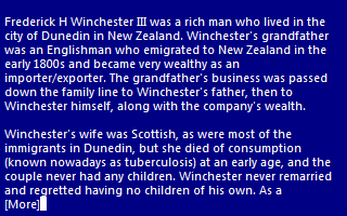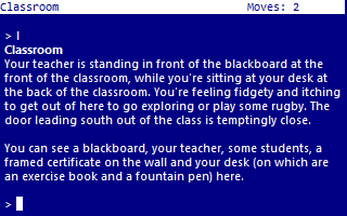
The Mystery of Winchester High (TALP)
Introduction
Frederick H Winchester III was a rich man who lived in the city of Dunedin in New Zealand. Winchester's grandfather was an Englishman who emigrated to New Zealand in the early 1800s and became very wealthy as an importer/exporter. The grandfather's business was passed down the family line to Winchester's father, then to Winchester himself, along with the company's wealth.
Winchester's wife was Scottish, as were most of the immigrants in Dunedin, but she died of consumption (known nowadays as tuberculosis) at an early age, and the couple never had any children. Winchester never remarried and regretted having no children of his own. As a consequence, when he retired, he became a philanthropist and donated thousands of pounds to children's charities, particularly those that supported the education of Maori children, as he had great admiration for the Maori people and their culture.
Frederick H Winchester III died on 30 April 1932. His mansion was willed to the city of Dunedin to be turned into a high school. The school was named Winchester High in honour of its benefactor. Apart from the mansion, the remainder of Winchester's vast fortune was never found and its whereabouts became known as The Mystery of Winchester High.
Years have passed and the school is now running into financial difficulties. If the school's principal cannot obtain funding, she will have to close the school.
As a student at the school, you didn't really care about the school closing, until your teacher happened to mention that all the students will be transferred to a worse school if funding is not found. With that revelation, you decide to solve the mystery and find Winchester's lost fortune.
It's rumoured that when the mansion was converted into a school, some parts of the former mansion were not used. You wonder whether the fortune could be found there...
Instructions
This is a traditional text adventure that was written for Text Adventure Literacy Jam 2023, 12 April to 31 May 2023. See the jam page for the competition rules.
A text adventure is a form of computer game that presents you with a story. You take on the role of the main character in the story and control that character's actions. The story has a goal and you will need to solve puzzles in order to achieve that goal. The computer tells you where you are, what you can see and what's happening around you. You can then move around, examine the things you find and manipulate those things by telling the computer what to do using simple English commands.
Commands consist of a verb phrase, optionally followed by a noun phrase. Most commands can be abbreviated to a verb followed by a noun. For example, GET THE FOUNTAIN PEN can be abbreviated to GET PEN.
If the verb is followed by a preposition, this may alter its meaning. For example, GET STOOL will attempt to pick up the stool, but GET ON STOOL will attempt to climb onto it.
In some cases, the verb phrase and first noun phrase may be followed by a second noun phrase. The two noun phrases are usually separated by a preposition. For example, HIT GLASS will attempt to hit the glass with your hands (as you didn't specify a second noun phrase), but HIT GLASS WITH BRICK will attempt to hit the glass with the brick. If you only use a verb and a noun, the game will generally tell you if it needs an extra phrase or implicitly try to deduce what is needed for the second phrase.
Don't panic! It's not as complicated as it sounds. Just use simple English sentences starting with a verb and it will all feel quite natural.
Movement
To move around, use commands like GO NORTH and GO SOUTH. You can move in any of the four cardinal compass directions, as well as UP and DOWN. To save typing, movement commands can be abbreviated to N, S, E, W, U and D. You can sometimes use other movement commands such as ENTER, EXIT, GET ON or GET OFF. These will be reasonably obvious when the time comes.
Examining things
Make sure you EXAMINE everything you come across, even insignificant things like scenery and objects mentioned in room descriptions, as subtle hints and clues are scattered everywhere. To save typing, EXAMINE can be abbreviated to X. For example, EXAMINE BLACKBOARD can be abbreviated to X BLACKBOARD.
You can also try your other senses when it seems appropriate, e.g. SMELL, TOUCH or LISTEN. Unlike EXAMINE, these actions aren't necessary to solve any puzzles, so don't feel obligated to use them.
Manipulating objects
Apart from examining things, most of your time will be spent manipulating objects. Use commands like GET or TAKE to pick up an object, e.g. GET BOOK. Use commands like DROP or DISCARD to drop an object, e.g. DROP BOOK. Use WEAR to wear something, e.g. WEAR UNIFORM. Use REMOVE to remove something that is already worn, e.g. REMOVE UNIFORM.
To see what you're currently carrying and wearing, use INVENTORY (or I). As you're not a pack horse, you can only carry ten items at a time, but you may be able to put things in containers if you need to increase your load.
There are many other verbs that can be used to manipulate objects. These will be fairly obvious when the time comes. Common verbs include OPEN, CLOSE, LOCK, UNLOCK, DRINK, PUSH, PULL and so on. Use PUT, PLACE or INSERT to put objects into containers or on supporters, e.g. PUT PEN IN DRAWER or PLACE BOOK ON DESK.
Communicating with characters
You will encounter a few characters in the game. When you first meet new characters, in addition to examining them, you should try talking to them, e.g. TALK TO TEACHER. To get further information from them, try asking them about something relevant, e.g. ASK TEACHER ABOUT MYSTERY. You can also try telling them about something, showing them something or giving them something, e.g. GIVE PEN TO JANITOR.
Advanced features
You can use IT or THEM to refer to the noun used in the previous command, e.g. GET BOOK, EXAMINE IT, READ IT.
You can refer to multiple objects by separating the objects with AND, e.g. GET BOOK AND PEN. Using IT and THEM in the next command will only refer to the last of those objects, e.g. EXAMINE IT will refer to the pen.
You can use ALL to refer to all the appropriate objects with GET and DROP, e.g. GET ALL to get everything in the current location, GET ALL FROM DESK to get everything on the desk, DROP ALL to drop everything you're holding.
When using ALL, you can use EXCEPT or BUT to exclude some objects, e.g. DROP ALL EXCEPT BOTTLE.
Finally, you can enter multiple commands on the same line by separating them with a period, e.g. UNLOCK DOOR. OPEN IT.
Scoring
There is no score in this game. Your objective is simply to ... well, that's for you to find out.
Other commands
Use LOOK (or L) to refresh the display.
Use VERSION to get the game version. Use ABOUT or INFO to get background information and credits for the game. Use CREDITS to get the credits only.
Use SAVE to save your progress. Use RESTORE to restore a saved game.
Use UNDO to undo the last move. This is handy if you change your mind, make a mistake. You shouldn't be able to get killed or get into an unwinnable situation in this particular game. (UNDO is not available with the z3 version of the game.)
Use AGAIN (or G) to repeat the last command.
Use WAIT (or Z) to do nothing apart from pass the time.
Use HELP to get a brief reminder of how to play the game or HINT to get a context-sensitive hint related to the current location. (This will be added later.)
Use RESTART to restart the game from the beginning. Use QUIT (or Q) to quit without restarting.
Most importantly, have fun, enjoy the game and try to solve the mystery of Winchester High.
Keyboard shortcuts
Some interpreters have keyboard shortcuts. If you are using an interpreter on a computer with a conventional keyboard, most will allow you to press the up and down arrow keys to cycle through your past commands. This is handy if you want to repeat the previous command or correct a typo.
Playing the game
There are two ways to play the game.
Click the Run game button (above) to play the game in a browser. (Coming later.)
Download the z5 file and play the game using a z-code interpreter (see below).
Finding a z-code interpreter
There are a variety of z-code interpreters for all the major platforms, as well as many minor and retro platforms. There are far too many to list here. The best source of downloads is probably the Interactive Fiction Archive. Navigate to infocom/interpreters for z-code interpreters and interpreters-multi for interpreters that interpret both z-code games and other formats.
Common z-code interpreters
Android: I recommend Hunky Punk from Google Play. (There are others, as well.)
iOS: I recommend Frotz from the Apple App Store. (There are others, as well.)
Linux: See the links above.
Mac: See the links above.
Windows: I recommend Windows Frotz from the infocom/interpreters link above. (There are others, as well.)
Credits
Inform 6 compiler, language and library originally written by Graham Nelson and now maintained by David Griffith, David Kinder, Andrew Plotkin et al.
PunyInform library written by Johan Berntsson and Fredrik Ramsberg based on the Inform 6 library.
Parchment interpreter written by Dannii Willis et al.
Original concept by Andre Persidsky.
Game design and coding by Garry Francis.
Testing by Christopher Merriner, Gianluca Girelli, Jade J Aincioa, John Ziegler, Larry Horsfield, Max Fog, Reiko Yukawa, Stephen Norris and Tabitha O'Connell.
| Updated | 13 days ago |
| Status | Released |
| Platforms | HTML5, Windows, macOS, Linux, Android |
| Release date | May 31, 2023 |
| Rating | Rated 5.0 out of 5 stars (1 total ratings) |
| Author | Garry Francis |
| Genre | Interactive Fiction |
| Tags | inform-6, Mystery, parser, punyinform, Retro, talp, text-adventure, Text based, Tutorial |
| Average session | About an hour |
| Languages | English |
| Inputs | Keyboard |
| Accessibility | Interactive tutorial, Blind friendly |




Comments
Log in with itch.io to leave a comment.
Thank you so much for this fun game! I am just staring with text adventures and the difficulty was spot on.
Thank you. I'm glad you enjoyed it. I have a few others that have a tutorial and are targetted at beginners, so give them a try: Kenny Koala's Bushfire Survival Plan is set in the Australian bush, Carpathian Vampire has a vampire theme based on a true story and Who Kidnapped Mother Goose? is my latest, inspired by the better-known Mother Goose nursery rhymes.
Thanks! Will definitely try those.
I really enjoyed these puzzles and the story. I have to say that I am a big fan of hints. I relied on them considerably, but it added to my overall commitment to the game. (731 moves!).
Thanks. The game was a lot of fun to write, so it's nice to hear that someone enjoyed it.